بهبود عملکرد لرزه ای کل ساختمان با استفاده از میراگرهای ویسکوز خطی مایع Improving total-building seismic performance using linear fluid viscous dampers
- نوع فایل : کتاب
- زبان : انگلیسی
- ناشر : Springer
- چاپ و سال / کشور: 2018
توضیحات
رشته های مرتبط مهندسی عمران
گرایش های مرتبط سازه و زلزله
مجله بولتن مهندسی زلزله – Bulletin of Earthquake Engineering
دانشگاه Department of Engineering Science – University of Oxford – UK
منتشر شده در نشریه اسپرینگر
کلمات کلیدی انگلیسی Fluid viscous dampers FEMA P-58 Concentric braced frames Nonstructural systems Damping
گرایش های مرتبط سازه و زلزله
مجله بولتن مهندسی زلزله – Bulletin of Earthquake Engineering
دانشگاه Department of Engineering Science – University of Oxford – UK
منتشر شده در نشریه اسپرینگر
کلمات کلیدی انگلیسی Fluid viscous dampers FEMA P-58 Concentric braced frames Nonstructural systems Damping
Description
1 Introduction Previous research has revealed that concentric braced frame (CBF) structures designed using the Eurocode (CEN 2010a) can experience structural and nonstructural damage during earthquakes. Achieving a desired seismic performance requires the coordination of structural and nonstructural performance. FEMA P-58 (FEMA 2012a) analyses conducted by Del Gobbo et al. (2017, 2018) revealed that Eurocode-compliant CBF structures are likely to experience extensive damage during both ultimate limit state (ULS) and serviceability limit state (SLS) earthquakes. The ULS earthquake, or no-collapse requirement in Eurocode 8 (CEN 2013), has a 10% probability of exceedance in 50 years. Structures are designed to withstand the ULS design seismic action while retaining structural integrity after the earthquake. The SLS earthquake, or damage limitation requirement in Eurocode 8, has a 10% probability of exceedance in 10 years. Damage at the SLS should be limited to a point that does not compromise building serviceability (CEN 2013). Interstorey drifts and floor accelerations were the main structural parameters that characterized seismic demand. Retrofitting buildings with supplemental damping devices can substantially reduce drifts and improve the seismic performance of buildings. FVDs have been identified as the most promising of these devices for nonstructural considerations as they can improve both drifts and floor accelerations, unlike hysteretic devices (Mayes and Wassim 2005; Astrella and Whittaker 2005; Christopoulos and Filiatrault 2006; Vargas and Bruneau 2006, 2007; Pavlou and Constantinou 2006; Dicleli and Mehta 2007; Wanitkorkul and Filiatrault 2008). This paper presents an investigation on the application of FVDs to minimize structural and nonstructural damage. Despite having the potential to be effective and economically viable solutions, research focusing on FVD applications for improving nonstructural seismic performance has been limited. (1) Previous research on the use of FVDs has focused on structural performance, while nonstructural performance is often not considered. (2) Structural parameters such as interstorey drifts and floor accelerations are often evaluated. Complexities arise as these parameters are often competing objectives. Limitations are introduced when determining appropriate parameter weights to represent performance. Other studies use damage indices that are influenced by several assumptions to represent performance. Our use of repair costs is a more appropriate measure of total-building seismic performance and avoids these limitations. (3) The optimal amount of damping with respect to repair costs has not been investigated. (4) There is also a need to clarify what seismic performance improvements can and cannot be achieved using supplemental damping.


